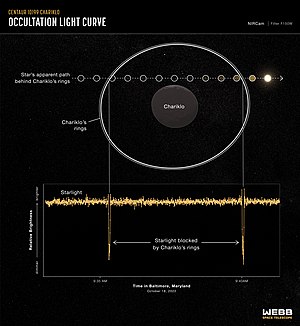
Back حلقات تشاريكلو Arabic حلقههای چاریکلو Persian Chariklon renkaat Finnish Anneaux de (10199) Chariclo French Aneis de Chariklo Galician Cincin Chariklo ID Anelli di Chariklo Italian Anéis de Cáriclo Portuguese Кольца Харикло Russian Chariklos ringar Swedish

The minor planet and centaur 10199 Chariklo, with a diameter of about 250 kilometres (160 mi), is the second-smallest celestial object with confirmed rings (with 2060 Chiron being the smallest[1]) and the fifth ringed celestial object discovered in the Solar System, after the gas giants and ice giants.[2] Orbiting Chariklo is a bright ring system consisting of two narrow and dense bands, 6–7 km (4 mi) and 2–4 km (2 mi) wide, separated by a gap of 9 kilometres (6 mi).[2][3] The rings orbit at distances of about 400 kilometres (250 mi) from the centre of Chariklo, a thousandth the distance between Earth and the Moon. The discovery was made by a team of astronomers using ten telescopes at various locations in Argentina, Brazil, Chile and Uruguay in South America during observation of a stellar occultation on 3 June 2013, and was announced on 26 March 2014.[2]
The existence of a ring system around a minor planet was unexpected because it had been thought that rings could only be stable around much more massive bodies. Ring systems around minor bodies had not previously been discovered despite the search for them through direct imaging and stellar occultation techniques.[2] Chariklo's rings should disperse over a period of at most a few million years, so either they are very young, or they are actively contained by shepherd moons with a mass comparable to that of the rings.[2][4][5] The team nicknamed the rings Oiapoque (the inner, more substantial ring) and Chuí (the outer ring), after the two rivers that form the northern and southern coastal borders of Brazil. A request for formal names will be submitted to the IAU at a later date.[4]
- ^ Cite error: The named reference
Ortiz2015was invoked but never defined (see the help page). - ^ a b c d e Cite error: The named reference
nature_paperwas invoked but never defined (see the help page). - ^ Cite error: The named reference
Reuterswas invoked but never defined (see the help page). - ^ a b Cite error: The named reference
ESO ringwas invoked but never defined (see the help page). - ^ Cite error: The named reference
nature_newswas invoked but never defined (see the help page).